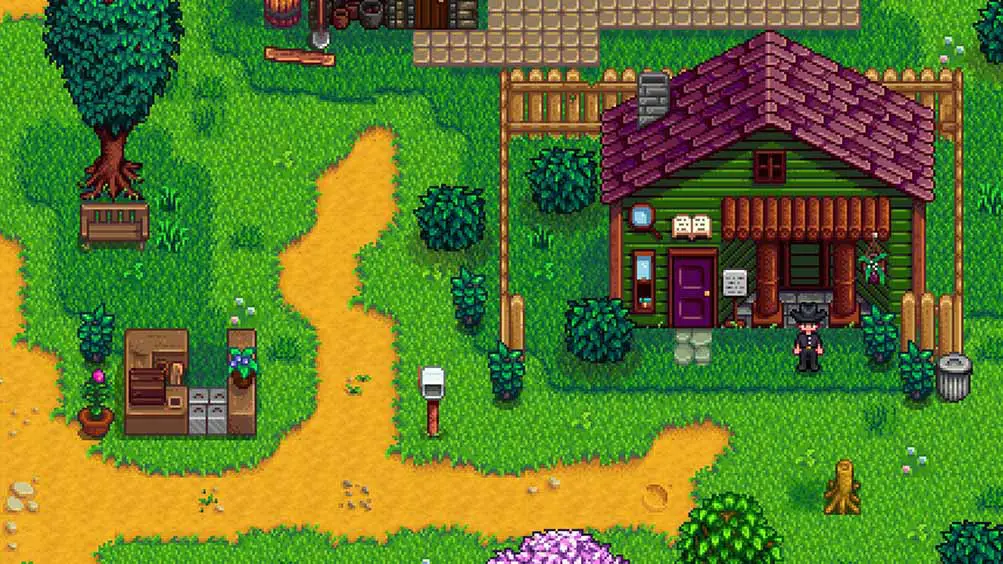As a huge fan of Stardew Valley, I’ve always been fascinated by the Museum. However, completing it can be a daunting task, especially for those new to the game. In this article, I’ll walk you through everything you need to know about completing the Stardew Valley Museum.
First, I’ll provide a brief overview of the game for those who may not be familiar with it. Then, I’ll explain the importance of the Museum and its rewards, so you can understand the value of completing this challenging task. With these insights, you’ll be well-equipped to embark on your Museum journey in Stardew Valley.
In the same way that the Stardew Valley Museum reveals hidden rewards and wonders for its virtual visitors, there exist in the real world unique and captivating museums like the Tim Burton one, that will take you on an unforgettable journey through the mind of visionary creators.
Importance of Museum and its rewards
The Stardew Valley Museum is crucial to completing the game as it enables you to donate artifacts and treasures. As you donate, you unlock rewards such as new areas and geode-crushing machines. Donating all items earns a trophy and a secret statue in the town square.
To begin organizing the museum, donate any found item or archeological discovery to Gunther, the curator of the museum in Pelican Town. To find rare items, fish in unique locations like the volcano or purchase from traveling merchants.
Unique details include donating duplicate items only in reward cases where there are multiple copies for several items to maximize completion efficiency. Collect five lost books scattered throughout town including one in an abandoned house unlocked via spring crops bundle.
Did you know completing the Stardew Valley Museum unlocks an annoying dog statue in the square following the donation of 1000 stones to Joja?
Watching TV for Luck
As an avid Stardew Valley player, one of my primary goals has always been completing the community museum. However, the process can be incredibly daunting, especially when it comes to getting certain items. That’s why I was excited to discover a somewhat unconventional method for improving my chances of finding rare museum items: watching TV for luck.
In this segment, I’ll take a look at two specific aspects of this luck-based strategy: utilizing the fortune teller for daily luck and exploring the impact of improved luck on gameplay. Let’s find out how effective this method really is!
Fortune teller for daily Luck
Using the fortune teller in Stardew Valley for daily luck can significantly impact the completion of the Museum. Here are four key points to keep in mind while utilizing this feature:
- The fortune teller is located on the bottom right side of the game map.
- The fortune teller provides players with their daily luck level, which ranges from -0.05 to +0.05.
- Luck affects several aspects of gameplay, including finding rare items and catching more fish.
- Checking the fortune teller every day can allow players to plan their activities and maximize their chances of success.
It’s worth noting that daily luck is not guaranteed to affect every activity, but it can still be beneficial to keep track of it when attempting to complete the Museum collection. To further improve chances, consider focusing on activities related to specific artifacts or areas of the Museum.
Utilize the fortune teller every day and prioritize activities based on daily luck levels. Remember that each item donated helps organize and expand the Museum’s display. Happy artifact hunting!
Effect of Luck on Gameplay
Players’ varying levels of luck have a significant effect on their gameplay experience in Stardew Valley. Luck determines the probability of, amongst many others, finding rare artifacts and ores from rocks and enemy drops, getting higher quality products from crops and forages, and catching rarer fish.
It also dictates events that transpire during the day, such as concerning the appearance of traveling merchants or the chance to strike up valuable conversations with villagers.
Luck affects all aspects of gameplay over time; however, some ways to improve it include gifting items to villagers on their birthdays or visiting Fortune Teller for guidance via daily predictions.
Additionally, eating special food dishes can bolster luck temporarily. Furthermore, modifying one’s gaming setup by adjusting game difficulty or using mods may either positively or negatively impact one’s overall experience. Therefore, paying close attention to these aspects is essential for optimizing gameplay.
To maximize your experience in Stardew Valley, be sure to explore every corner for hidden treasures that will benefit you. Be mindful of the seasons and work accordingly towards specific tasks; timely completion guarantees success in unlocking numerous items that make your progress easier.
Focusing on painting your character’s portrait red by contributing adequately to town development activities like donating sufficient resources to complete the museum collection is crucial to unlocking this content-rich game completely.
Ultimately, full engagement with NPCs (Non-Player Characters), whether through farming quest hints or mining the resource-laden caves surrounding Stardew Village helps improve your fortune in-game drastically.
Finding Artifacts in Artifact Spots
One of the most efficient ways to collect artifacts is by locating them in artifact spots scattered throughout the map. In this section, we’ll talk a little about how to find these artifact spots and the benefits of trying to uncover every last one.
We’ll also cover how to use the hoe to discover artifacts, which can make the search for those last few tricky artifacts much easier. So, let’s get started and see how we can complete the Stardew Valley Museum together!
Identifying Artifact Spots
Finding artifact spots is an essential part of completing the museum collection in Stardew Valley. To complete the collection, players must first identify these locations and then do some digging. Here’s a four-step guide to help you do just that.
- Look for Worms – Worms are the most common indicator you’ll find above potential artifact spots. They’re found on tilled soil or grassy patches and appear as small wriggling lines.
- Check for Dig Spots – While exploring, keep an eye out for areas with small X-shaped indentations in the ground or loose dirt clusters indicating that an item can be found there.
- Investigate other Items – Pay attention to other things in the environment such as tall grass, trees, and rocks, as they may conceal artifact spots beneath them.
- Use Hoe Tool – You can activate any of these hidden spot indicators by striking them with your hoe tool. If it’s an artifact spot, metallic clanging will sound from your phone after it gets hoed.
It is important to note that identifying artifact locations often requires a sharp eye and some patience but becomes easier over time with practice.
Fun fact: The developer of Stardew Valley, ConcernedApe (aka Eric Barone), designed the entire game over four years before its initial release in 2016.
Using the Hoe to uncover artifacts
Hunting for artifacts is a critical aspect of completing the museum in Stardew Valley. Utilizing the hoe to uncover ancient objects and collectibles is an effective method of filling your portals.
- Choose a Location: Selecting the right place is the initial step; sandy soils around town, fields, cliffs, and mines provide good opportunities. Keep an eye out for worms that appear on land after it rains or on vegetation-covered soil.
- Use your Tools: After identifying a feasible location, use your hoe to till up little square plots. Artifacts may appear in clumps of dirt as sparkling dirt tiles or bonus bags.
- Preservation is Key: After retrieving obtainable finds from the soil, bring them to Gunther.
If you’re lucky, unearthing artifact troves could reveal rare treasures worth more significant coin amounts or even museum incentives!
Approach potential digging sites with patience and attention since some areas require skill such as breaking rocks with bombs or utilizing special tools.
One memorable incident involved discovering valuable tablets by chance while clearing mushrooms. It only goes to show that Stardew Valley hides many secrets worth uncovering!
Fishing for Treasure
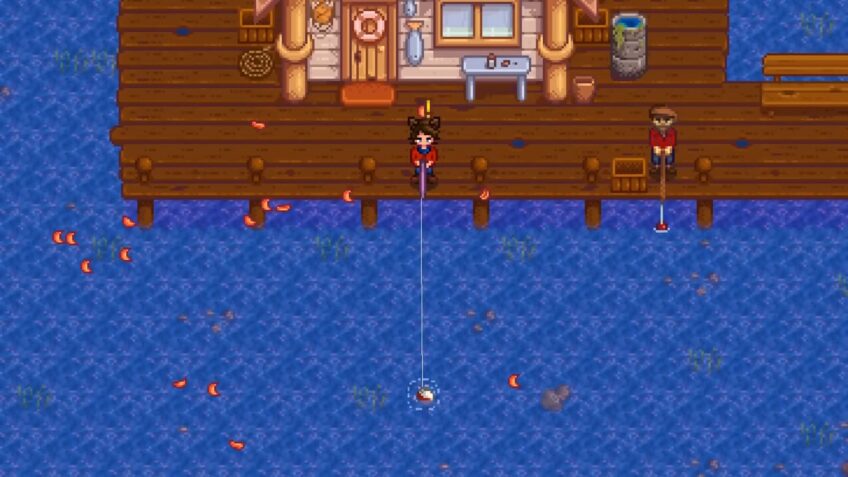
Have you ever played Stardew Valley and wondered how to complete the museum collection without spending a fortune on the market? In this part of the guide, I’ll share with you some tips and tricks for fishing out the missing treasures in your collection.
First, keep an eye out for the treasure chest icons while fishing – they indicate valuable items that can be donated to the museum. Next, let’s talk about the importance of the Luck buff – it can significantly increase your chances of finding treasures while fishing.
Lastly, we’ll explore the benefits of using the Treasure Hunter tackle, which improves your odds of catching valuable items.
By the end of this guide, you’ll be well on your way to completing the Stardew Valley museum collection with ease.
Treasure chest icons while fishing
When fishing in Stardew Valley, players may encounter treasure chest icons. These icons represent the possibility of obtaining valuable items or artifacts that can be donated to the museum for rewards.
- Treasure chest icons have a chance of appearing when fishing.
- Fishing in certain locations or using bait can increase the likelihood of finding treasure.
- Artifacts found through these icons are needed to complete the museum collection.
- Donating all artifacts will unlock secret rewards like the Mermaid Pendant.
It’s important to note that some artifacts may be difficult to obtain and require specific conditions or luck. Additionally, duplicates can still appear even after all artifacts have been collected.
In Stardew Valley, completing the museum collection is a challenging yet rewarding task. Not only does it offer unique rewards, but it also adds depth to the game’s lore and world-building.
Importance of Luck Buff and Treasure Hunter Tackle
To complete the Stardew Valley Museum, luck buff, and Treasure Hunter tackle are essential components. The Luck buff increases the chances of obtaining rare items and artifacts while the Treasure Hunter tackle doubles the probability of getting treasures.
- Luck buff greatly enhances artifact hunting in various locations
- Treasure Hunter tackle is highly effective in getting treasure chest drops from fishing
- Use Iridium Rods to catch fish with great quality
- Always carry a Sturdy Ring or Glow Ring while exploring mines for better visibility and a higher chance of finding hidden spots
- Use bombs to break cracked walls to reveal passages leading to stairs or more loot
- Avoid digging any worm tiles as they usually contain only low-quality items that do not count towards the museum collection.
Successfully completing the museum requires donating every item, including all 95 curated artifacts. Make sure to visit every location, mine every ore vein, and dig through every dirt tile. Also, be sure to keep a proper record of each donated item’s location in the museum.
Exploring the Mines for Artifacts

As a Stardew Valley player, completing the Museum collection can be a daunting task. However, exploring the mines for artifacts is an exciting way to achieve this goal.
In this section, I’ll share my personal experience with finding artifacts in the Mines. We’ll start by exploring the different types of gem nodes and geodes available in the Mines. Then, I’ll share how monsters that inhabit the Mines can drop artifacts, making it an excellent place to seek out hidden gems. So grab your pickaxe and let’s get mining!
Gem Nodes and Geodes in the Mines
The Mines in Stardew Valley contain valuable resources, including Gem nodes and Geodes. These can be donated to the Museum for rewards and to complete the collection.
- Gem nodes are rocks that contain precious gems such as diamonds, emeralds, and rubies. They are found while mining in the lower levels of the Mines.
- Geodes are small spherical stones containing minerals or fossils. They may be discovered while mining or can be purchased from the Blacksmith for a varying price.
- Once donated to the Museum, gems, and minerals will be displayed in their appropriate exhibit, adding variety and color to the collection. Some rewards will also be given for donating specific items.
Stardew Valley’s mines have a deep history with artifacts filled with the character through their origins in how people used them long ago. By discovering these artifacts through exploration of The Mines players can get a glimpse into what life was like hundreds of years ago when ancestries roamed around trying to make an honest living.
Monsters dropping artifacts in the Mines
Mines are known to be the ultimate source of hidden treasures in Stardew Valley. Players can explore these caves indefinitely to find precious gems, metals, and other useful items. Monsters in the mines tend to drop various artifacts during combat that players can use to enrich their museum collections.
Here are six points that further explain the monsters dropping artifacts in the mines:
- Ancient Seeds are a rare artifact that drops from Dust Sprites; it is used as a Crop for greenhouses.
- Ghosts have a chance to drop Solar Essences, which also have many crafting uses.
- The prehistoric Scapula is an artifact found by hitting floating debris and boxes.
- The Bat Wing can be obtained by killing Bats. It’s used for energy tonics and other potions.
- Bone Flute artifacts can be turned into Skeletons by a Wizard at Cindersap Forest (1,000g).
- Players may obtain Frozen Tears by defeating Frozen Geodes that can be obtained from some mine levels or fishing Treasure Chests.
Stardew Valley Museum organizing requires careful planning and dedication. The player must turn over any discovered artifact such as Ancient Sword or Copper Pan you acquire on your journey, as they might hold unique information about this region’s history.
Archaeology allows one to organize materials based on their relevance to one another within the exhibit, so finding all the available pieces should always be considered valuable.
It is fascinating how players can donate all types of mining treasures for others’ amusement while earning significant rewards with no real-world consequences.
A true fact to share is that donating all museum articles would give players massive rewards – Stardew Valley gold coins, star tokens, and even key items!
Artifact Troves
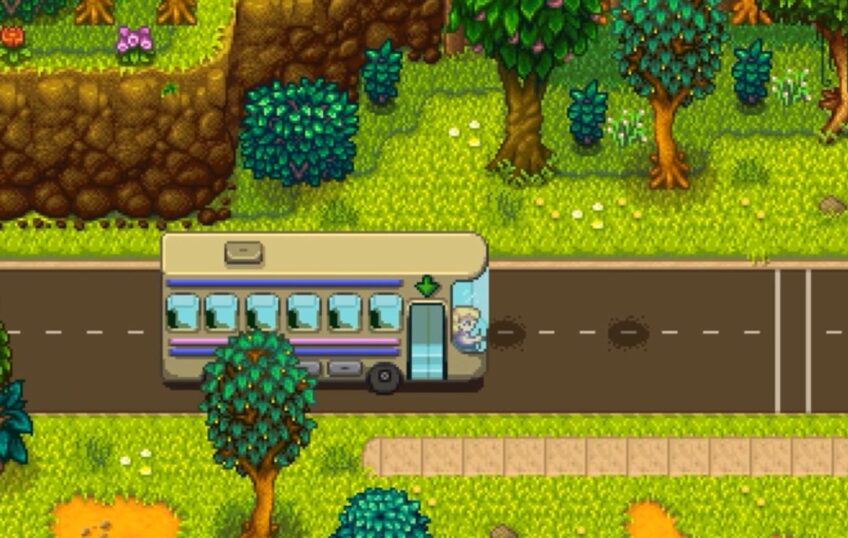
As a diehard Stardew Valley player, I know that one of the most challenging and gratifying aspects of the game is completing the Museum collections. One of the best ways to find rare artifacts is through Artifact Troves, which can yield bundles of goodies that boost your collections.
In this segment, we’ll go over the purchase of Artifact Troves and finding them in Haunted Skulls. We’ll also explore what the Museum expansion means for your collections and offer some tips for completing the Museum for those elusive rewards.
According to Stardew Valley Wiki, Artifact Troves can be obtained by digging up Artifact Spots or dropped from Mystical Tablets while Haunted Skulls have a higher probability of spawning in the Skull Cavern and on levels with the Treasure Room.
Purchase of Artifact Troves
If you’re a fan of completing collections, the Stardew Valley Museum is one of your priorities. Artifact troves are purchasable treasures ideal for completing the collection.
Here are three points to consider when purchasing artifact troves:
- Artifact troves can only be bought from traveling merchants and for a hefty price.
- The contents of artifact troves are randomly generated, meaning there is no guarantee that you will receive an item needed to complete the museum collection.
- If completing your museum collection is your goal, purchasing an artifact trove can be worth it, especially if you have extra gold lying around.
Additionally, it’s crucial to note that donating the same artifact twice doesn’t double the rewards in return. Avoid repeatedly submitting items already included in the system.
Finding them in Haunted Skulls
Stardew Valley players can discover artifact troves while exploring the game. The artifacts can be found in various locations, including the Haunted Skulls.
Below are six points to finding artifact troves in haunted skulls:
- Haunted Skulls are located in the Submerged Paths.
- The Submerged Paths open up after completing the Community Center Bundles.
- You need a skull key to open the door to the Skull Cavern.
- The Skull Cavern is where you can find numerous artifact troves.
- Completing certain levels of the Skull Cavern unlocks additional floors with better loot and more challenging enemies.
- Be sure to have a weapon and enough health items before venturing into the caverns.
It’s worth noting that players must first complete specific bundles at the Community Center or JojaMart before unlocking access to certain areas.
Additionally, having high-quality items such as weapons and health supplies is vital for survival in these perilous areas.
Some suggestions for players include enhancing their combat skills by leveling up, crafting good quality gear, bringing bombs and pickaxes for mining, and waiting until later stages of gameplay before trying to tackle difficult challenges. By doing this, players increase their chances of success while playing Stardew Valley.
Dig Site on Ginger Island
Have you unlocked the Dig Site on Ginger Island yet in Stardew Valley? It’s a treasure trove of ancient artifacts and prehistoric treasures just waiting to be discovered. In this portion of the game, you can find rare prehistoric bones and unlock access to even more parts of the island.
In this section, we’ll be discussing how to unlock access to Ginger Island and the Dig Site, as well as the best strategies for finding those elusive bones. So grab your pickaxe and let’s get exploring!
Unlocking access to Ginger Island
To gain entry to Ginger Island and unlock all of its resources, one must undertake a specific set of tasks and accomplish them successfully. These objectives primarily involve obtaining various artifacts that can be found in Stardew Valley’s different locations, such as the desert or the mines.
Once these artifacts have been collected, players can then trade them with the Museum on display at Pelican Town for access to Ginger Island. Here is a six-step guide on how to unlock access to Ginger Island:
- Collect all of the 95 artifacts currently available in Stardew Valley.
- Donate them to the Museum displayed in Pelican Town via Gunther the Curator until all available categories are completed.
- After completing all collections at the Museum, speak with Gunther to receive a prize: a special key that can be used in Calico Desert.
- In Calico Desert, locate a secret area via the use of this special key.
- Finish the quest offered by the Dwarf in this underground location by collecting several items from different checkpoints.
- Lastly, once you’ve fulfilled both previous quests mentioned above, Mayor Lewis will provide an approved entrance to Ginger Island.
It’s important to note that each step must be accomplished thoroughly before progressing to later steps smoothly. Players should also remember daily donation limits and prioritize searching for missing artifact pieces after donating many duplicates; otherwise, this task becomes extremely time-consuming.
The reward for unlocking access is very beneficial – players can now mine iridium and obtain various unique fruits and plants not available anywhere else.
Finding prehistoric bones at the Dig Site
At the Dig Site in Stardew Valley, players can find prehistoric fossils that can be donated to the museum. These fossils are buried in various locations at the site and must be dug up using a hoe.
Once players have uncovered a fossil, they can bring it to the museum and donate it to complete their museum collection. The donation process is simple – go to the museum’s front desk and interact with it, choose a present that matches your artifact, and then place it on the donation arrow.
It’s important to note that not all artifacts are found at the Dig Site. Some artifacts require specific fishing spots, while others are found by exploring various in-game locations like mines.
Overall, artifact hunting is an essential part of completing the Stardew Valley Museum. By collecting every item available and donating them to the museum, players can receive many rewards and a sense of achievement.
Fun Fact: In 2019, Stardew Valley creator ConcernedApe released an update that added a nighttime event involving an Annoying Dog NPC from Undertale who appears in front of JojaMart wearing sunglasses.
Enchanting Tools at the Volcano Forge
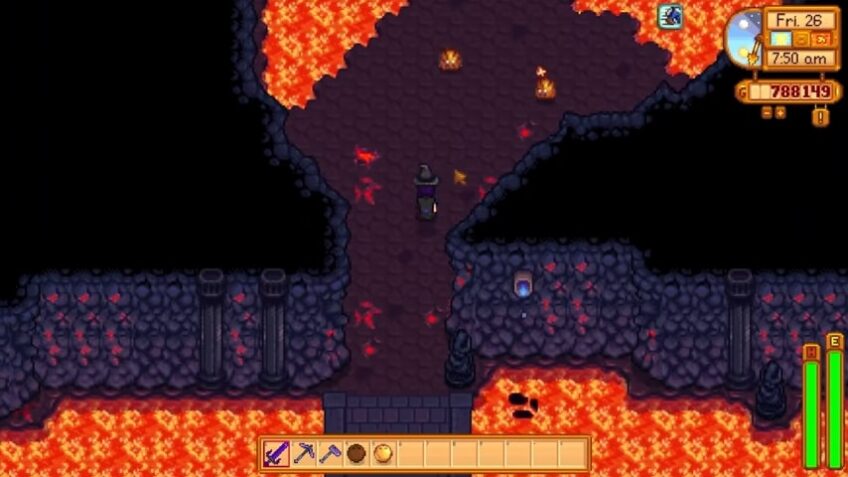
As a Stardew Valley enthusiast, I’ve spent countless hours exploring every nook and cranny of the game. One of the most exciting aspects for me was completing the museum collection, which requires some serious artifact-hunting skills. In this guide, I’ll be discussing one of the key tools in this process – enchanting tools at the Volcano Forge.
Specifically, we’ll explore the effects of different enchantments on finding artifacts, as well as the cost and rerolling process for these enchantments. Plus, we’ll touch on an expansion that adds even more possibilities for artifact hunters. So grab your pickaxe and let’s get started!
Effects of different enchantments on Finding artifacts
Different enchantments have varying effects on finding artifacts in the Stardew Valley Museum. Enchantments can improve your chances of discovering rare items and completing the museum’s collection.
- Enchant Pickaxe – increases chances of finding artifacts in ground surfaces.
- Enchant Fishing Rod – increases chances of obtaining artifacts while fishing.
- Enchant Hoe – increases the likelihood of finding ancient seeds to donate to the museum.
- Enchant Weapon – helps players defeat monsters quickly and within a shorter duration, meaning they spend less time-fighting monsters and more time artifact hunting.
Investing in these enchantments can speed up progress toward completing the museum’s collections.
It is vital to note that some artifacts are exclusively found when using specific tools enchanted with specific types of ore. Learning where and how to find these artifacts would significantly boost your collection.
Several strategies can help you optimize artifact hunting, such as focusing on one type of artifact at a time, building an organized layout around the museum, keeping track of donated items, and dedicating specific days for artifact hunting. These methods will streamline progress toward completing collections while saving time and resources.
Cost and rerolling for enchantments
Players who wish to complete their museum collection can obtain enchantments for their tools at the Volcano Forge. These enchantments come with a cost and require rerolling to perfect them.
- Cost: The price of enchants varies depending on the type of tool. For example, a pickaxe enchants may cost more than a hoe enchant, so players should plan accordingly.
- Rerolling: If players aren’t satisfied with the initial enchantment they receive, they can reroll it, which will cost more. However, this allows for the opportunity to obtain a better enchantment.
- Enchantment Types: There are different types of enchantments that players can get for their various tools, such as efficiency or fortune. These provide unique bonuses for specific tasks.
It is important to note that players cannot obtain every single type of enchantment at once and would require several attempts to get any desired result.
Players who aim to complete their Stardew Valley Museum should not overlook the importance of obtaining enchanted tools and donating collected artifacts. It is all part of an organized effort toward completing the museum collection.
A True History about this topic shows that Community Feedback influenced these changes in Stardew Valley’s Volcano Forge Update back in early 2021 where different tiers of Tool Enchantment were introduced to add variety and challenge among players during their Artifact Hunting journey.
Choosing the Right Professions
Have you been playing Stardew Valley for a while but can’t seem to complete the museum collection? I was stuck in the same situation until I realized the importance of choosing the right profession. In this part, let’s discuss how some professions in Stardew Valley can aid the completion of the museum collection.
Additionally, we will talk about an overlooked strategy of shifting professions at the Statue of Uncertainty, which can turn the game around for avid collectors. So, if you want to get your hands on that illustrious stardrop, read on!
Professions helpful in the completion of Museum
The museum collection in Stardew Valley is an essential part of the game, but completing it can be challenging. Certain Professions can help you complete the collection faster.
| Profession | Description |
| Archeologist | Unlocks the ability to receive new Artifacts as rewards for geode smashing and worm hunting. |
| Gatherer | Chance to get double harvests from foraging, which includes Artifact spots on certain maps. |
| Fisher | Enables the catching of powerful Legendary Fish that can be donated to the museum. |
In addition to these three Professions, there are also other helpful tips and strategies for completing the museum collection in Stardew Valley. Keep visiting the mines and lower levels, fishing at every opportunity, and digging on artifact spots on certain maps.
Suggested Tips:
- Keep up with all daily tasks including fishing, digging, and mining.
- Bringing friends along. Dividing artifacts makes them easier to obtain.
- Fishing often takes time but will increase your chances of catching legendary fish that could be donated to museums.
- Visit unique locations like Skull Cavern that may have rare items.
- With several extra artifacts can trade other items for missing objects at exchange stations or use duplicates.
- Catching all fish species or donating enough minerals would result in great rewards like access to the treasure trove.
FAQs
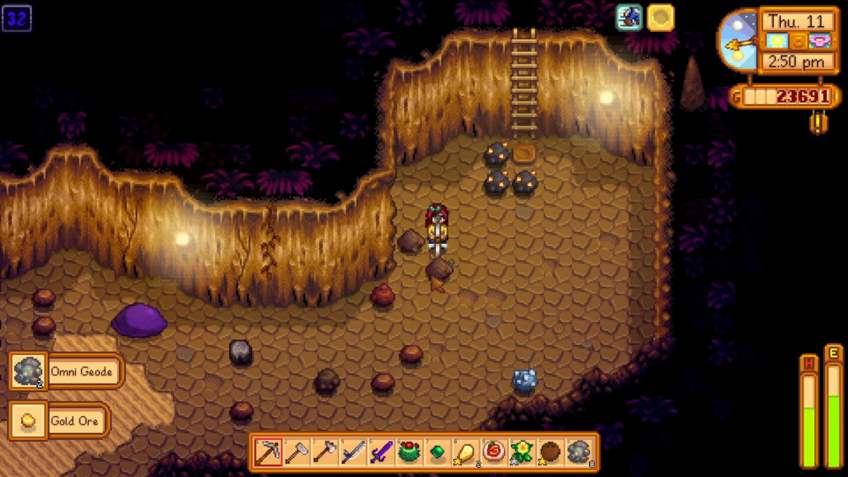
Where is it located?
The museum in Stardew Valley can be found in the northeast of Pelican Town, just beside the Mayor’s Manor.
How can I donate to the museum in Stardew Valley?
Simply interact with the donation box found inside the museum. You can donate any items you’ve found and explore the various collections present in the museum.
What is the layout of the SDV museum?
The museum in Stardew Valley is divided into different sections featuring various collections. The entrance and the starting room feature the fish collection. From there, you can venture through different rooms to explore the other collections like minerals, artifacts, and items related to town history.
What is the complete museum collection in Stardew Valley?
The complete collection consists of 95 items across various collections, including 23 minerals, 20 geodes, 35 artifacts, and many more.
How do I organize the museum in Stardew Valley?
To organize the museum in Stardew Valley, you can use the “organize” option, which is available after donating items to the museum. By selecting this option, you can arrange your donated items by collection and add descriptions for each item.
What are the rewards for completing the museum in Stardew Valley?
Upon completing the collection, you will receive a Stardew hat. Additionally, completing individual collections will earn you different rewards, such as the geode crusher for completing the mineral collection or the treasure trove for completing the artifacts collection.
Five Well-Known Facts About Completing the Stardew Valley Museum:
- ✅ To complete the museum, you must donate one of every item in the game. (Source: Stardew Valley Wiki)
- ✅ The items must be donated to the correct location within the museum, or they will not count towards completion. (Source: Stardew Valley Wiki)
- ✅ Some items can only be found by fishing or killing specific monsters, so it’s important to explore and engage with all aspects of the game. (Source: GamesRadar+)
- ✅ Completing the museum awards players with the Stardew Hero achievement and a special prize from Gunther, the curator. (Source: IGN)
- ✅ Completing the museum can be a challenging but rewarding aspect of the game, providing a sense of accomplishment and contributing to the overall story and world-building of Stardew Valley. (Source: Screen Rant)
Conclusion
In conclusion, completing the Stardew Valley Museum can be a daunting task, but it’s well worth the effort. Donating artifacts and treasures not only unlocks rewards such as new areas and geode-crushing machines but also earns a trophy and a secret statue in the town square.
By following the tips and strategies outlined in this article, players can efficiently complete the museum and reap the benefits of their hard work. With the Museum journey in Stardew Valley underway, players can explore new areas and discover rare items while enhancing their gaming experience.
After mastering the intricacies of completing the Stardew Valley Museum, you might also enjoy exploring and conquering challenges in other immersive worlds, such as the intriguing and lore-rich environment of Skyrim.

